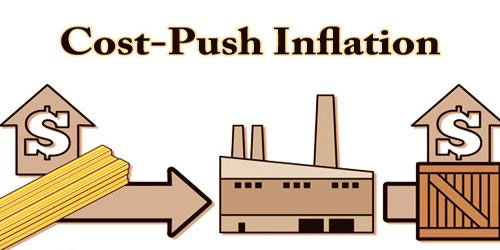Differences Between Demand-Pull and Cost-Push Inflation
Oct 28, 2022 By Susan Kelly
What is Inflation?
Economists continue to argue over the precise factors that lead to inflation, often known as a general price increase. Inflation may be defined as a nationwide rise in costs. According to monetarist theoretical approaches, the monetary base is the primary cause of inflation because money increases in an economy resulting in a rise in overall prices. If you compare Cost-Push Inflation Vs Demand-Pull Inflation, according to the cost-push inflation theory, greater costs for consumers result when increased expenses for producers (caused by factors such as rising salaries) are transferred to customers. Whereas the idea behind demand-pull inflation is that prices will increase whenever there is an extended time during which aggregate demand is higher than the supply of currently available products.
Cost-Push Inflation

When total prices go up, that phenomenon is referred to as inflation. Inflation results in rises in the value of workers and commodities, referred to as cost-push inflation. If manufacturing costs rise, the market's entire output, or "aggregate supply," may fall. Cost-push inflation arises when producers pass on rising costs to consumers without corresponding demand increases.
A market's inflation rate is the rate at which the prices of a predetermined range of products and services increase over time. Inflation can reduce a consumer's buying ability if wages have not grown sufficiently or kept pace with growing costs. If a company's manufacturing costs increase, corporate leaders could decide to pass those costs along to consumers by raising prices. A further fall in profits is likely if the firm does not raise pricing in response to rising production costs.
An increase in the cost of production is a major contributor to cost-push inflation, and this increase may be expected or unexpected. Manufacturing costs might rise, for instance, if the price of inputs like raw materials and inventories goes up.
It is necessary for there to be no change in the level of the product's demand that is being influenced by the increases in production costs for there to be an instance of cost-push inflation. The manufacturers of the good or service will boost the prices they charge the consumer to reimburse for the cost of manufacturing capacity. This will allow them to keep their profit margins stable while maintaining the anticipated level of consumer needs.
Demand-Pull Inflation

An economy can experience inflation when there is an overall trend of considering the increase in the prices of products. A state that economists refer to as "a lot of bucks hunting for fewer available products" best describes the dynamic that gives rise to demand-pull inflation, which drives up prices by exerting an upward influence on supply levels. A rise in aggregate demand can also cause this particular form of inflation.
An economic boom may be the source of a rise in aggregate requests. This is because businesses have to hire more individuals to raise their productivity. A competitive employment market will increase pay, leading to increased demand.
Differences Between Demand-Pull and Cost-Push Inflation
Cost-Push Inflation Vs Demand-Pull Inflation may be differentiated from one another clearly due to the following premises:
- Inflation that may be attributed to increased consumer demand for goods is referred to as demand-pull inflation. Some instances fall under the category of demand-pull inflation. These are situations where there has been a growth in demand to such a degree that production cannot keep up. Cost-push inflation is caused by increasing supplier costs, whereas demand-pull inflation is caused by rising consumer demand. However, both types of inflation increase prices that end users ultimately bear.
- An instance of demand-pull inflation occurs whenever overall economic growth grows at a pace that is higher than the overall quantity supplied. Cost-Push Inflation is the outcome of a rise in the costs of inputs that are the outcome of the shortfall of production costs which causes a reduction in the number of outputs, which will lead to the rate of outputs increasing.
- The term "demand-pull inflation" refers to the process through which prices begin to rise. In contrast, cost-push inflation explains why it is so challenging to control inflation once it has begun.
- The rise in money supply, increased expenditure by the authorities, and fluctuating exchange rates are the primary contributors to demand-pull inflation. On the other hand, the most significant contributors to cost-push inflation are the monopolistic entities that exist inside the community.
- The economic and fiscal policy that equates to a high degree of joblessness is related to the economic suggestion on demand-pull inflation. This proposal is meant to address inflation caused by demand. In contrast, cost-push inflation is characterized by a policy prescription connected to effective supervision over price spikes and revenue strategies. The purpose of the latter is to maintain hyperinflation management without contributing to an increase in joblessness.
Is There Always a Downside to Inflation?
In principle, a modest rate of inflation is seen to be an encouraging indicator of a flourishing economy. However, rising inflation might hurt the economy, and consider that some subsets of the population may benefit from inflation. For instance, those who borrow money at fixed rates of interest seem to profit from inflation, whereas those who lend money and save money suffer losses due to inflation.
Conclusion
You may draw the following conclusion from the material presented earlier: the primary factor contributing to the economy's inflation rate is either the demand-pull that contributes to the rise of price or the cost-push factor. It is a common topic of debate among economists to determine which of the two factors that generate an initial rise in the overall level of prices is the more significant contributor to inflation. According to the consensus of leading economists, the demand-pull factor is the primary contributor to inflation in every economy.








